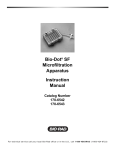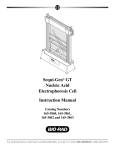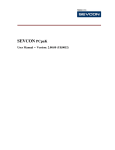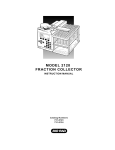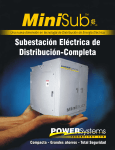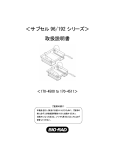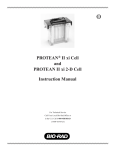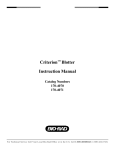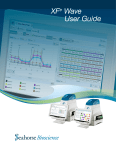Download Bio-Rad User`s Guide for Gel Boxes
Transcript
Sub-Cell GT Agarose Gel Electrophoresis Systems ® Instruction Manual Catalog Numbers 170-4401 to 170-4406 170-4481 to 170-4486 For Technical Service Call Your Local Bio-Rad Office or in the U.S. Call 1-800-4BIORAD (1-800-424-6723) Warranty Bio-Rad Laboratories warrants the Sub-Cell GT, Wide Mini-Sub® cell GT, and Mini-Sub cell GT electrophoresis systems against defects in materials and workmanship for 1 year. If any defects occur in the instrument during this warranty period, Bio-Rad Laboratories will repair or replace the defective parts free. The following defects, however, are specifically excluded: 1. Defects caused by improper operation. 2. Repair or modification done by anyone other than Bio-Rad Laboratories or an authorized agent. 3. Use of fittings or other spare parts supplied by anyone other than Bio-Rad Laboratories. 4. Damage caused by accident or misuse. 5. Damage caused by disaster. 6. Corrosion due to use of improper solvent or sample. This warranty does not apply to parts listed below: 1. Platinum Electrode Wires To insure the best performance from the Sub-Cell GT electrophoresis systems, become fully acquainted with these operating instructions before use. Bio-Rad recommends that you first read these instructions carefully. Assemble and disassemble the unit completely without casting a gel. After these preliminary steps, you should be ready to cast and run a gel. Bio-Rad also recommends that all Sub-Cell GT system components and accessories be inspected for damage, cleaned as recommended in this manual, and rinsed thoroughly with distilled water before use. Record the following for your records: Model Catalog No. Date of Delivery Warranty Period Serial No. Invoice No. Purchase Order No. For any inquiry or request for repair service, contact Bio-Rad Laboratories after confirming the model and serial number of your instrument. Table of Contents Page Section 1 General Information....................................................................................1 1.1 1.2 1.3 1.4 Introduction ................................................................................................................1 Safety ..........................................................................................................................1 System Components...................................................................................................2 Specifications .............................................................................................................4 Section 2 Operating Instructions ................................................................................4 2.1 2.2 2.3 2.4 2.5 DNA Gel Preparation.................................................................................................4 Casting Agarose Gels.................................................................................................6 Electrophoresis ...........................................................................................................8 Nucleic Acid Staining and Visualization...................................................................9 Note on Blotting .......................................................................................................10 Section 3 Gel and Electrophoresis Reagent Preparation .......................................10 Section 4 Care and Maintenance...............................................................................11 4.1 4.2 4.3 4.4 4.5 Cleaning Sub-Cell GT Components ........................................................................12 Compatible Cleaning Agents ...................................................................................12 Maintenance Schedule .............................................................................................12 Electrode Replacement.............................................................................................13 RNase Decontamination ..........................................................................................14 Section 5 Troubleshooting..........................................................................................14 Section 6 Product Information..................................................................................15 6.1 6.2 6.3 Sub-Cell GT Systems...............................................................................................15 Sub-Cell GT System Accessories ............................................................................16 Related Bio-Rad Products........................................................................................18 Section 7 References ...................................................................................................21 Section 1 General Information 1.1 Introduction The Sub-Cell GT instruments (basic Sub-Cell GT cell, Wide Mini-Sub® cell GT, and MiniSub cell GT) comprise a comprehensive and flexible gel electrophoresis system that effectively separates nucleic acids using submerged agarose gels. Submarine agarose gels are easy to cast and readily dissipate heat. These gels allow sample underlaying and prevent electrical field discontinuities caused by wicks or sample well dehydration. Agarose gels are ideal for the separation of DNA restriction digestions, Polymerase Chain Reaction (PCR*)-amplified fragments, and genomic DNA and RNA prior to Southern or northern blotting. If operated correctly, agarose gel submarine electrophoresis can effectively separate nucleic acids from 20 base pairs to 20 kilobase pairs in length. The Sub-Cell GT systems are designed for years of reproducible and rigorous use. These rugged systems incorporate many features that make casting and running agarose gels simple and efficient. The gel caster provides tape-free gel casting in trays. Gels can also be cast in the GT bases using specially designed wedge gates. Replaceable electrode cassettes provide a simple way to replace electrode wires. A comprehensive assortment of base and tray sizes, including a variety of preparative, analytical, and multichannel pipet compatible combs, makes these systems ideal for any agarose gel application. Note: This manual contains instructions for the Sub-Cell GT electrophoresis systems only. Prior to the release of the Sub-Cell GT systems, Bio-Rad supplied similar agarose gel electrophoresis cells: the original Sub-Cell DNA electrophoresis cell, Wide Mini-Sub cell, and MiniSub cell systems. This manual does not provide information on these earlier versions. Contact your local Bio-Rad representative for information concerning the original Sub-Cell systems. Definition of Symbols ! Caution, risk of electrical shock 1.2 Safety Caution (refer to accompanying documents) ! The Sub-Cell GT electrophoresis systems are designed for maximum user safety. The buffer chambers are made of 3/16 inch (.476 cm) thick injection-molded acrylic to create a leak-free electrophoresis environment. The safety lids surround the buffer chamber to protect the user from exposure to electrical currents. All Sub-Cell GT systems were designed for indoor use only. Before use, inspect the GT base for cracks or chips, which may allow the buffer to leak from the base and cause a potential electrical hazard. Additionally, inspect all electrical cables, banana jacks, and plugs for loose connections, cracks, breaks, or corrosion. Do not use any part that is cracked, charred, or corroded. These parts may also cause a potential electrical hazard. Contact your local Bio-Rad representative before using a part that may be considered hazardous. During electrophoresis, inspect the base and workbench for any signs of buffer leakage. If leaking buffer is detected, disconnect the power to the cell immediately and contact your local Bio-Rad representative. Power to Sub-Cell GT units is supplied by an external DC voltage power supply. This power supply must be ground isolated in such a way that the DC voltage output floats with 1 respect to ground. All of Bio-Rad’s power supplies meet this important safety requirement. The recommended power supply for this apparatus is the PowerPac 300 power supply. The PowerPac 300 power supply contains safety features such as no load, overload, rapid resistance change, and ground leak detection capabilities. The maximum specified operating parameters for the Sub-Cell GT systems are given in Table 1.1. Table 1.1 Sub-Cell GT systems operating parameters Maximum voltage limit Maximum power limit Maximum Buffer temperature Sub-Cell GT Cell Wide Mini-Sub Cell GT Mini-Sub Cell GT 200 VDC 40 Watts 40 ˚C 150 VDC 45 Watts 40 ˚C 150 VDC 10 Watts 40 ˚C Current to the cell, provided from the external power supply, enters the unit through the lid assembly, providing a safety interlock. Current to the cell is broken when the lid is removed. Do not attempt to circumvent this safety interlock, and always turn the power supply off before removing the lid or when working with the cell. Important: These Bio-Rad instruments are certified to meet IEC 1010-1** safety standards. IEC-certified products are safe to use when operated in accordance with the instruction manual. This instrument should not be modified in any way. Alteration of this instrument will: • • • Void the manufacturer’s warranty Void the IEC 1010-1 safety certification Create a potential safety hazard IEC 1010-1 certification applies to equipment designed to be safe between the operating temperatures of 4 °C and 40 °C and altitudes up to 2,000 meters. Instruments are also safe at a maximum relative humidity of 80% for temperatures up to 31 °C decreasing linearly to 50 % at 40 °C. Bio-Rad is not responsible for any injury or damage caused by the use of this instrument for purposes other than those for which it is intended, or by modifications of the instrument not performed by Bio-Rad or an authorized agent. No user-serviceable parts are contained in this apparatus. To insure electrical safety, do not attempt to service this apparatus. 1.3 System Components Each of the Sub-Cell GT systems comes with the components listed in Table 1.2 (see Figure 1.1 for part description). Check your instrument to be sure all items are present. Note any damage to the unit which may have occurred during shipping. Notify Bio-Rad Laboratories if any items are missing or damaged. Table 1.2 Sub-Cell GT System Components Item GT Base (buffer chamber) Gel Casting Gates Safety Lid and Cables UVTP Gel Tray Fixed Position Comb Leveling Bubble Gel Caster (optional) Instruction Manual Sub-Cell GT System Quantity Wide Mini-Sub Cell GT System Quantity 1 1 2 2 1 1 1 1 2 2 (15 well, 1.5 mm thick) (15 well, 1.5 mm thick) (20 well, 1.5 mm thick) (20 well, 1.5 mm thick) 1 1 1 1 1 1 2 Mini-Sub Cell GT System Quantity 1 2 1 1 2 (8 well, 1.5 mm thick) (15 well, 1.5 mm thick) 1 1 1 Safety lid Electrical cables Fixed height comb Comb slots Banana plug/ Electrode wire assembly Fluorescent ruler UVTP gel tray Electrical leads Gel casting gates GT Base Safety Lid removal peg Leveling feet Fixed height comb Fluorescent ruler Leveling feet UVTP gel tray Cam lever Gel caster Leveling bubble Leveling feet Fig.1.1. Sub-Cell GT parts. 3 1.4 Specifications Sub-Cell GT Wide Mini-Sub Cell Mini-Sub Cell System GT System GT System GT base footprint (L x W x H) GT base buffer volume✝ GT base gel size Gel tray sizes 42 x 19.5 x 10 cm 1,500–2,000 ml 15 x 15 cm 15 x 10 cm 15 x 15 cm 15 x 20 cm 15 x 25 cm 26 x 20 x 7.5 cm 650–900 ml 15 x 7 cm 15 x 7 cm 15 x 10 cm 26 x 12 x 6.5 cm 265–320 ml 7 x 7 cm 7 x 7 cm 7 x 10 cm Construction GT base Gel casting gates Safety lid Banana plug/electrode cassette Banana plugs Electrodes Electrical cables Electrical leads Gel tray Combs Gel casting device Molded clear plastic Aluminum Molded clear plastic Molded polycarbonate Gold-plated brass, 4.4 cm length Platinum, 0.25 mm diameter Dual, 20 AWG, tinned copper wire cable Flame-retardant polyurethane insulation jacket Nickel silver UV-transparent acrylic plastic (UVTP) Molded plastic and machined acrylic Polycarbonate 0.64 cm silicon foam ✝ GT base buffer volumes will vary depending on the size and thickness of the gel used. Section 2 Operating Instructions Note: See Section 3, Gel and Electrophoresis Reagent Preparation, for information on the preparation of RNA gels. See References 1 and 2 for more information on DNA and RNA electrophoresis. 2.1 DNA Gel Preparation DNA agarose gels can be used to separate and visualize DNA of various sizes. Before casting an agarose gel, consult Table 2.1 to determine the appropriate percent agarose gel to use, based on the size of DNA to be separated. Procedure 1. Determine the amount of agarose (grams) required to make the desired agarose gel concentration and volume. Use Tables 2.1 and 2.2 as a guide for agarose concentration and gel volume requirements. Example: For a 1% agarose gel, add 1 gram of agarose to 100 ml of 1x electrophoresis buffer. 4 Table 2.1 Gel Concentration Required for DNA Separation1-2 Gel Concentration (%) 0.50 0.75 1.00 1.25 1.50 2–5* * DNA Size (Kb) 1–30 0.8–12 0.5–10 0.4–7 0.2–3 0.01–0.5 Sieving agarose such as AmpliSize® agarose Table 2.2 Gel Volume Requirements Gel Size Base 7 x 7 cm 15 x 7 cm 15 x 15 cm Tray 7 x 7 cm 7 x 10 cm 15 x 7 cm 15 x 10 cm 15 x 15 cm 15 x 20 cm 15 x 25 cm 0.25 cm thick 0.5 cm thick 0.75 cm thick 1.0 cm thick 10 ml 20 ml 50 ml 20 ml 40 ml 100 ml 30 ml 60 ml 150 ml 40 ml 80 ml 200 ml 10 ml 15 ml 20 ml 30 ml 50 ml 70 ml 90 ml 20 ml 30 ml 40 ml 60 ml 100 ml 140 ml 180 ml 30 ml 45 ml 60 ml 90 ml 150 ml 210 ml 270 ml 40 ml 60 ml 80 ml 120 ml 200 ml 280 ml 360 ml 2. Add the agarose to a suitable container (e.g., 250 ml Erlenmeyer flask, Wheaton bottle, etc.). Add the appropriate amount of 1x electrophoresis buffer (see Section 3, Gel and Electrophoresis Reagent Preparation, for electrophoresis buffer preparation) and swirl to suspend the agarose powder in the buffer. If using an Erlenmeyer flask, invert a 25 ml Erlenmeyer flask into the open end of the 250 ml Erlenmeyer flask containing the agarose. The small flask acts as a reflux chamber, allowing long or vigorous boiling without much evaporation. Note: A mark can be put on the lower flask at the same level as the liquid. If evaporation occurs, water can be added to bring the liquid back to the original starting level. 3. The agarose can be melted by boiling on a magnetic hot plate (Step 4a) or in a microwave oven (Step 4b). Caution: Always wear protective gloves, goggles, and a lab coat while preparing and casting agarose gels. The vessels containing hot agarose can cause severe burns if allowed to contact skin. Additionally, molten agarose can boil over when swirled. Magnetic Hot Plate Method 4a. Add a stir bar to the undissolved agarose solution. Heat the solution to boiling while stirring on a magnetic hot plate. Bubbles or foam should disrupt before rising to the neck of the flask. Microwave Oven Method 4b. Place the gel solution into the microwave. Using a low to medium setting, set the timer for a minimum of 5 minutes, stopping the microwave oven every 30 seconds and swirling the flask gently to suspend the undissolved agarose. This technique is the fastest and safest way to dissolve agarose. 5. Boil and swirl the solution until all of the small translucent agarose particles are dissolved. With the small flask still in place, set aside to cool to 60 °C before pouring. 5 2.2 Casting Agarose Gel Slabs There are several ways to cast agarose submarine gels using the Sub-Cell GT systems. Gels may be cast with or without a UV-transparent plastic (UVTP) tray directly on the stage of the Sub-Cell GT bases using the gel casting gates. Gels may also be cast on the removable UVTP trays with the aid of the gel caster or with standard laboratory tape. Casting gels on the base stages 1. Level the Sub-Cell base using the leveling bubble provided. 2. Slide the gel casting gates into the slots at opposite ends of the gel stage. 3. Place the comb(s) into the appropriate slot(s) of the base so that the sample wells are near the cathode (black). DNA samples will migrate toward the anode (red) during electrophoresis. 4. Prepare the desired concentration and amount of agarose in 1x electrophoresis buffer (see Section 2.1). When the agarose solution has cooled to 50–60 ˚C pour the molten agarose between the gates. Warning: Hot agarose (>60 ˚C) may cause the plastic in the cell to warp or craze and will decrease the lifetime of the Sub-Cell base. Warping may also result in sample wells of uneven depth. 5. Allow 20–40 minutes for the gel to solidify at room temperature. 6. Carefully remove the comb from the solidified gel. Remove the gel casting gates. 7. Submerge the gel beneath 2 to 6 mm of 1x electrophoresis buffer (see Section 3, Gel and Electrophoresis Reagent Preparation). Use greater depth overlay (more buffer) with increasing voltages to avoid pH and heat effects. Casting Gels on the Base Stage With UVTP Tray 1. Level the cell using the leveling bubble provided. 2. Place the UVTP tray on the cell base stage. Note: The Mini-Sub cell GT requires the 7 x 7 cm UVTP tray for casting in the base. The Wide-Mini-Sub cell GT requires the 15 x 7 cm UVTP tray and the Sub-Cell GT system requires the 15 x 15 cm UVTP tray for casting in the base. 3. Slide the gel casting gates into the slots at opposite ends of the base stage. Insure the gates are evenly seated in the slots and the gates uniformly contact all edges of the UVTP tray. The weight of the gates provides a tight seal to prevent any leakage problems during gel casting. 4. Place the comb(s) into the appropriate slot(s) of the trays so that the sample wells are near the cathode (black). DNA samples will migrate toward the anode (red) during electrophoresis. 5. Prepare the desired concentration and amount of agarose in 1x electrophoresis buffer (see Section 2.1). When the agarose solution has cooled to 50-60 °C, pour the molten agarose between the gates. Warning: Hot agarose (>60 °C) may cause the tray to warp or craze and will decrease the lifetime of the tray. Warping may also result in sample wells of uneven depth. 6. Allow 20-40 minutes for the gel to solidify at room temperature. 7. Carefully remove the comb from the solidified gel. Remove the gel casting gates. 8. Submerge the gel beneath 2 to 6 mm of 1x electrophoresis buffer (see Section 3, Gel and Electrophoresis Reagent Preparation). Use greater depth overlay (more buffer) with increasing voltages to prevent pH and heat effects. 6 Removable tray (UVTP) gel casting using a Gel Caster or Mini-Gel Caster 1. Level the Gel Caster or Mini-Gel Caster using the leveling feet in the gel caster and the leveling bubble provided. 2. Disengage and slide the movable wall to the open end of the Gel Caster or Mini-Gel Caster by turning and lifting the cam peg upward. Note: If casting more than one gel with the Gel Caster, add the removable gel casting wall to the gel caster. The removable wall will allow casting of two 15 x 10 cm trays, four 7 x10 cm trays or one 15 x 10 cm and one 15 x15 cm trays. 3. Place the open edge of the UVTP tray against the fixed wall of the Gel Caster or Mini-Gel Caster. 4. Slide the movable wall against the edge of the UVTP tray (Figure 2.1). 5. To seal the open tray ends, engage the cam peg by turning and pressing downward simultaneously. 6. When the cam peg has dropped into the appropriate slot, turn the peg in either direction until resistance is felt. This action seals the edges of the tray for casting. 7. Place the comb(s) into the appropriate slot(s) of the tray. Lift cam lever up Movable wall of gel caster Fixed wall of gel caster Engage and seal (press down and rotate) Sli de for wa rd Fig. 2.1. Sealing the UVTP tray for gel casting. 8. Prepare the desired concentration and amount of agarose in 1x electrophoresis buffer (see Section 2.1). When the agarose solution has cooled to 50–60 ˚C pour the molten agarose between the gates. Warning: Hot agarose (>60 ˚C) may cause the tray to warp or craze and will decrease the lifetime of the tray. Warping may also result in sample wells of uneven depth. 7 9. Allow 20–40 minutes for the gel to solidify at room temperature. 10. Carefully remove the comb from the solidified gel. 11. Disengage the cam peg by turning and lifting upward. Slide the movable wall away from the tray. Remove the tray from the Gel Caster or Mini-Gel Caster. Note: While the gel is solidifying, a light seal is formed between the gasket and the gel (especially for low percentage agarose gels [<0.8%]). Before moving the wall away from the tray, carefully lift the tray on one side to release the seal or use a spatula to break the seal between the agarose and gasket. 12. Place the tray onto the leveled Sub-Cell base so that the sample wells are near the cathode (black). DNA samples will migrate toward the anode (red) during electrophoresis. 13. Submerge the gel beneath 2 to 6 mm of 1x electrophoresis buffer (see Section 3, Gel and Electrophoresis Reagent Preparation). Use greater depth overlay (more buffer) with increasing voltages to avoid pH and heat effects. Removable tray (UVTP) gel casting using tape 1. Seal the ends of the UVTP gel tray securely with strips of standard laboratory tape. Press the tape firmly to the edges of the gel tray to form a fluid-tight seal. 2. Level the gel tray on a leveling table or workbench using the leveling bubble provided with the instrument. 3. Prepare the desired concentration and amount of agarose in 1x electrophoresis buffer (see Section 2.1). When the agarose solution has cooled to 50–60 ˚C pour the molten agarose into the gel tray. Warning: Hot agarose (>60 ˚C) may cause the tray to warp or craze and will decrease the lifetime of the tray. Warping may also result in sample wells of uneven depth. 4. Allow 20–40 minutes for the gel to solidify at room temperature. 5. Carefully remove the comb from the solidified gel. 6. Remove the tape from the edges of the gel tray. 7. Place the tray onto the leveled Sub-Cell base so that the sample wells are near the cathode (black). DNA samples will migrate toward the anode (red) during electrophoresis. 8. Submerge the gel under 2 to 6 mm buffer (see Section 3, Gel and Electrophoresis Reagent Preparation). Use greater depth overlay (more buffer) with increasing voltages to avoid pH and heat effects. 2.3 Electrophoresis After the agarose gel has solidified, sample loading and electrophoresis can begin. Agarose gels can be run in many different types of electrophoresis buffers. Nucleic acid agarose gel electrophoresis is usually conducted with either Tris-Acetate-EDTA (TAE) buffer or TrisBorate-EDTA (TBE) buffer. While TAE buffer provides faster electrophoretic migration of linear DNA and better resolution of supercoiled DNA, TBE buffers have a stronger buffering capacity for longer or higher voltage electrophoresis runs. Bio-Rad offers premixed 50x TAE and 10x TBE buffers, as well as individual buffer reagents for use with the Sub-Cell GT systems. 1. Prepare samples for gel loading. The maximum sample loading volumes for Bio-Rad’s combs are listed in Section 6.2. Loading volume is dependent upon the type of comb used (i.e., well thickness and length) and thickness of the gel. 8 2. When loading volume is determined, add standard nucleic acid sample loading dye to a final 1x concentration to make samples dense for underlaying into sample wells (see Section 3, Gel and Electrophoresis Reagent Preparation, for sample loading dye preparation). 3. Load the samples into the wells using standard pipets. Multichannel pipets can be used for loading samples only with the Bio-Rad MP combs (see Section 6.2). Note: Sample wells are often difficult to see. Well visualization can be enhanced by placing black paper or tape under the base or trays where comb placement or well formation is common. 4. Place the lid on the DNA cell carefully. Do not disturb the samples. The Sub-Cell GT system lids attach to the base in only one orientation. To attach the lid correctly, match the red and black banana jacks on the lid with the red and black banana plugs of the base. 5. Power requirements vary depending on gel thickness, length and concentration, and type of electrophoresis buffer used. Refer to Tables 2.3 and 2.4 for relative sample migration rates and for DNA size migration with sample loading dyes for the different Sub-Cell GT systems. Note: Buffer recirculation is not required for most standard DNA and RNA agarose gel electrophoresis. If buffer recirculation is required, simply turn off the power supply, remove the safety lid, and mix the running buffer as desired. After the buffer has been mixed, reconnect the safety lid and continue electrophoresis. Table 2.3 Relative Sample Migration Rates* Cell Type Sub-Cell GT cell, 15 x 15 cm gel Wide Mini-Sub cell GT, 15 x 10 cm gel Mini-Sub cell GT, 7 x 10 cm gel Voltage 75 V 75 V 75 V Bromophenol Blue Migration Rate 3.0 cm/hr 4.5 cm/hr 4.5 cm/hr * These sample migration rates were determined based on a 0.5 cm thick 1.0% agarose gel using Bio-Rad’s Molecular Biology Certified Agarose in 1x TAE electrophoresis buffer (diluted from Bio-Rad’s Premixed 50x TAE Buffer). Migration rates will vary depending on the voltage, current, and type of agarose or buffer used. Table 2.4 DNA size migration with sample loading dyes Agarose Concentration (%) 0.5–1.5 2.0–3.0** 4.0–5.0** Xylene Cyanol 4–5 Kb 750 bp 125 bp Bromophenol Blue 400–500 bp 100 bp 25 bp ** Sieving agarose such as AmpliSize agarose. 2.4 Nucleic Acid Staining and Visualization Gels can be removed from the base or gel tray for nucleic acid staining. The gel can also remain on the UVTP gel tray for staining. Ethidium Bromide Staining Procedure 1. Place the gel into the appropriate volume of 0.5 µg/ml ethidium bromide (EtBr) stain for 15–30 minutes. Use enough staining solution to cover the entire gel. Caution: Ethidium bromide is a suspected carcinogen and should be handled with extreme care. Always wear gloves, eye glasses, and a laboratory coat. Dispose of used EtBr solutions and gels appropriately (Review EtBr Material Safety Data Sheet [MSDS] for proper disposal methods). 2. Destain the gel for 10–30 minutes in dH2O using the same volume used for staining. Note: Ethidium Bromide can be removed from the DNA with extended destaining. This will cause lower sensitivity of detection. However, insufficient destaining will create higher background fluorescence. 9 3. Rinse the gel briefly with dH2O to remove any residual staining solution. 4. Place the gel on a UV transilluminator for nucleic acid visualization and analysis. DNAEthidium Bromide complexes may be illuminated with UV light of 254, 302, or 366 nm. Sensitivity decreases with illumination at higher wavelengths. However, nicking of DNA will increase below 302 nm. Table 2.5 gives the percentage of transmittance of UV light through 1/4” (.64 cm) UV-transparent plastic. Note: Nucleic acids in the gel can be visualized through the UVTP trays. If a UVTP tray is not used, place household plastic wrap between the UV transilluminator and the gel to avoid contaminating the transilluminator with nucleic acids or EtBr. Table 2.5 Percent UV Transmittance through 1/4” (.64 cm) UV Transparent Plastic (UVTP) Approximate % Transmittance 0 80 90 Wavelength (nm) 254 302 360 5. Photograph the gel using standard cameras and film (e.g., Bio-Rad’s Standard Polaroid Gel Documentation System) or with CCD-based digitized image analysis systems (e.g., Gel Doc™ 1000 UV fluorescent gel documentation system). Gels are generally photographed with a yellow, orange, or red interference filter. Red filters generally give the cleanest background. Bio-Rad offers a full-line of standard photography and CCD-based imaging systems for nucleic acid gel analysis. 2.5 Note on Blotting Nucleic acids within the gel can be transferred to membranes using the techniques of Southern and Northern blotting. It is beyond the scope of this instruction manual to include blotting procedures. Consult references 1 and 2 for blotting techniques. Bio-Rad offers a full line of nitrocellulose and positively charged nylon membranes, as well as vacuum and electrophoretic blotting apparatus for Southern and Northern blotting. Section 3 Gel and Electrophoresis Reagent Preparation RNA Agarose Formaldehyde Gels For 100 ml of a 1% agarose formaldehyde gel prepare as follows: 62 ml of 1.6% melted agarose 20 ml 5x MOPS electrophoresis buffer (1x final concentration) 18 ml 12.3 M (37.5%) formaldehyde (2.2 M final concentration) Caution: Formaldehyde solutions and formaldehyde vapors are toxic. When handling solutions or gels that contain formaldehyde use a chemical hood. Always wear gloves, eye glasses, and a laboratory coat while using formaldehyde. See the MSDS for safety information. Nucleic Acid Electrophoresis Buffers1-2 DNA agarose gel electrophoresis is usually conducted with either Tris-Acetate-EDTA (TAE) or Tris-Boric Acid-EDTA (TBE). While TAE provides faster electrophoretic migration of linear DNA and better resolution of supercoiled DNA, TBE buffers have a stronger buffering capacity for longer or higher voltage electrophoresis runs. Bio-Rad offers premixed 50x TAE and 10x TBE buffers for use with the Sub-Cell GT systems. RNA formaldehyde gels require a MOPS [3-(N-morpholino)-propanesulfonic acid] electrophoresis buffer. 10 1x Tris-Acetate-EDTA (TAE)—40 mM tris (pH 7.6), 20 mM acetic acid, and 1 mM EDTA. 50x Stock (1 liter)—dissolve in 600 ml distilled water: 242 g tris base (FW = 121) 57.1 ml glacial acetic acid 100 ml 0.5 M EDTA (pH 8.0). Fill to a final volume of 1 liter with distilled water. 1x Tris-Boric Acid-EDTA (TBE)—89 mM tris (pH 7.6), 89 mM boric acid, 2 mM EDTA 10x Stock (1 liter)—dissolve in 600 ml distilled water: 108 g tris base (FW = 121) 55 g boric acid (FW = 61.8) 40 ml 0.5 M EDTA (pH 8.0) Fill to a final volume of 1 liter with distilled water. 1x MOPS Buffer (RNA Gels)—0.02 M MOPS [3-(N-morpholino)-propanesulfonic acid] (pH 7.0), 8 mM sodium acetate, 1 mM EDTA (pH 8.0) 5x Stock (1 liter)—dissolve in 600 ml DEPC-treated distilled water: 20.6 g MOPS 13.3 ml 3 M sodium acetate (DEPC treated), pH 7.4 10 ml 0.5 M EDTA (DEPC-treated), pH 8.0 Fill to a final volume of 1 liter with DEPC-treated distilled water. Caution: DEPC is a suspected carcinogen. Always wear gloves, eye glasses, and a laboratory coat. Use caution when handling DEPC containing solutions. Consult the DEPC MSDS (Material Safety Data Sheet) for more information. DNA and RNA Sample Loading Dye1-2 A convenient 10x sample buffer stock consists of 50% glycerol, 0.25% bromophenol blue, and 0.25% xylene cyanole FF in 1x TAE buffer. Only 1–10 ml of the 10x loading dye should be prepared. RNA Sample Preparation1-2 Prior to loading RNA onto an agarose formaldehyde gel prepare each RNA sample as follows: 6 µl RNA in DEPC-treated water 10 µl 5x MOPS buffer (final concentration 1.67x) 9 µl 12.3 M formaldehyde (final concentration 3.7 M) 25 µl formamide (final concentration 50% v/v) Caution: Formamide is a teratogen. Always wear gloves, eye glasses, and a laboratory coat. Use caution when handling formamide. Consult the formamide MSDS for more information. Ethidium Bromide Solution Add 10 mg of EtBr to 1 ml distilled water. Bio-Rad offers EtBr solutions (10 mg/ml). Section 4 Care and Maintenance 4.1 Cleaning Sub-Cell GT Components 1. All Sub-Cell GT system parts should be washed with a mild detergent solution in warm water. Note: Be careful not to snag or break the electrode wire in the GT base while cleaning. 2. Rinse all parts thoroughly with warm water or distilled water and air dry, if possible. 11 4.2 Compatible Cleaning Agents Chemically compatible cleaners must be used to insure long life of parts. These include: • Aqueous solutions of soaps and mild detergents: Bio-Rad Cleaning Concentrate (catalog number 161-0722) Dishwashing liquid • Organic Solvents: Hexane Aliphatic hydrocarbons Do not leave plastic parts to soak in detergents more than 30 minutes. A short detergent rinse typically is all that is required. Caution: Do not use the following chemicals to clean Sub-Cell GT parts. Exposure to these chemicals may cause the plastic parts to crack, craze, etch, or warp. • Chlorinated Hydrocarbons Carbon tetrachloride Chloroform • Aromatic Hydrocarbons Benzene Phenol Toluene Methyl ethyl ketone Acetone • Alcohols Methanol Ethanol Isopropyl alcohol Do not use abrasive or highly alkaline cleaners on Sub-Cell GT parts. Do not expose Sub-Cell GT parts to temperatures >60 ˚C. Do not sterilize Sub-Cell GT parts by autoclaving or dry heat. 4.3 Maintenance Schedule Item All parts Electrical cables Trays Electrode wires Cable connections (banana jacks and plugs) GT base Look For Dried salts, agarose, grease, and dirt Breaks or fraying Chips or cracks Breaks Frequency Each use Looseness Weekly Crazing, cracks, or leaks Monthly 12 Each use Each use Each use Action Clean parts as described in Section 4.1 Replace cables Replace tray See Section 4.4 (Electrode Cassette Replacement) Replace banana jacks or banana plug holders Replace GT base or banana plug holder o-ring 4.4 Electrode Replacement The Sub-Cell GT systems allow easy replacement of broken electrode wires by removing the banana plug/electrode wire assembly and ordering a new assembly from Bio-Rad (Figure 4.1). Order the new assembly using the part description and catalog numbers listed in Section 6, Product Information. 1. Remove the thumb screw and rubber gasket from the banana plug chamber of the GT base to release the banana plug/electrode wire assembly. Do not discard this thumb screw or rubber gasket (keep these parts with the GT base). 2. Remove the broken wire assembly by lifting upward on the banana plug. Discard the broken assembly. 3. Insert the new assembly into the banana plug chamber of the GT base. Make sure the electrode wire guard guides are properly seated into the electrode wire guard slots in the bottom of the GT base. 4. Replace and tighten the thumb screw and rubber gasket to secure the assembly in the base and to form a leak-free seal in the banana plug holder chamber. Note: Test for buffer leakage, by filling the base with water and checking for leakage of water through the banana plug chamber of the base. If leakage occurs, tighten the thumb screw. Banana plug Electrode wire Banana plug/ Electrode wire assembly O-ring Banana plug chamber Rubber gasket Thumb screw Fig. 4.1. Removal of banana plug/electrode wire assembly. 13 4.5 RNase Decontamination Sub-Cell GT parts can be cleaned with a mild detergent and treated for 10 minutes with 3% hydrogen peroxide (H2O2), and then rinsed with 0.1% DEPC- (diethyl pyrocarbonate) treated distilled water, to eliminate RNases prior to using the Sub-Cell GT systems for RNA gels.1-2 Consult references 1-2 for other suggestions regarding the use of DEPC in RNase decontamination. Caution: DEPC is a suspected carcinogen. Always wear gloves, eye glasses, and a laboratory coat. Use caution when handling DEPC-containing solutions. Consult the DEPC MSDS for more information. Do not attempt to RNase decontaminate Sub-Cell GT parts using extreme dry heat. Note: Several commercial products are available for eliminating RNase contamination. RNaseZAP™ (Ambion) is a safe, simple, and effective method that if used properly does not craze or fog the Sub-Cell GT parts. See manufacturer’s instructions for proper use. Section 5 Troubleshooting Symptoms Cause Solutions Slanted lanes (bands) Gel not fully solidified Comb warped or at an angle Let gel solidify for at least 30–45 minutes. Check alignment of comb. Curved line or distortion of lanes (bands) Bubbles in sample wells Remove bubbles prior to electrophoresis. Differential relative mobilities Sample spilled out of wells Samples should have proper density. Apply carefully. Unit not leveled Level unit. Place on steady work bench. Curved bands, smiles Sample overload Reduce load. Ragged bands Sample density incorrect See sample application instructions. Sample well deformed Carefully remove comb, especially from soft gels. Be sure gel has solidified. Cooling soft gels aids in comb removal. Excessive power or heating Reduce voltage. See electrophoresis instructions. Agarose has improper endosmosis (mr) Consult Bio-Rad about agarose. Salt concentration in sample too high Reduce salt concentration to ≤ 0.1 M. Excessive power and heating Reduce voltage. See electrophoresis instructions. Sample spilled out of well Apply sample carefully. Increase gel thickness for large sample volumes. Adjust comb height. Incomplete digest, nuclease contamination, bad enzyme Heat sample. Check enzyme activity. Digest sample further. Band smearing and streaking 14 Symptoms Cause Solutions Sample wells cast through the gel. Sample leaks along bottom of running surface. Comb should be placed 1 to 2 mm above the base of the running surface. Sample overload Dilute sample. Too high gel percentage Lower gel percentage. Incomplete digest Check enzyme activity, digest further. High MW bands sharp; Low MW bands smeared Gel percentage too low Increase gel percentage. Switch to polyacrylamide. Gels crack Too high voltage gradient, especially with low melting temperature agarose or low gel strength gels Reduce voltage. Run gel at lower temperature. Bands sharp but too few bands seen Section 6 Product Information 6.1 Sub-Cell GT Systems Catalog Number Product Description 170-4401 Sub-Cell GT System, with 15 x 10 cm tray 170-4402 Sub-Cell GT System, with 15 x 15 cm tray 170-4403 Sub-Cell GT System, with 15 x 20 cm tray 170-4404 Sub-Cell GT System, with 15 x 25 cm tray 170-4481 Sub-Cell GT System, with 15 x 10 cm tray and gel caster 170-4482 Sub-Cell GT System, with 15 x 15 cm tray and gel caster 170-4483 Sub-Cell GT System, with 15 x 20 cm tray and gel caster 170-4484 Sub-Cell GT System, with 15 x 25 cm tray and gel caster 170-4405 Wide Mini-Sub Cell GT System 170-4485 Wide Mini-Sub Cell GT System, with gel caster 170-4406 Mini-Sub Cell GT System 170-4486 Mini-Sub Cell GT System, with gel caster Sub-Cell GT/PowerPac 300 Power Supply Systems* 165-4349 Sub-Cell GT/PowerPac 300 System, 100/120 V 165-4350 Sub-Cell GT/PowerPac 300 System, 220/240 V 165-4348 Wide Mini-Sub Cell GT/PowerPac 300 System, 100/120 V 165-4351 Wide Mini-Sub Cell GT/PowerPac 300 System, 220/240 V 165-4347 Mini-Sub Cell GT/PowerPac 300 System, 100/120 V 165-4352 Mini-Sub Cell GT/PowerPac 300 System, 220/240 V * All Sub-Cell GT/PowerPac 300 systems come with 15 x 15 cm UVTP tray and gel caster. 15 6.2 Sub-Cell GT System Accessories Catalog Number Product Description Sub-Cell GT Systems 170-4410 Sub-Cell GT Base 170-4411 Sub-Cell GT Safety Lid with Cables 170-4412 Gel Caster 170-4413 Sub-Cell GT Electrode (Anode), red 170-4414 Sub-Cell GT Electrode (Cathode), black 170-4415 Sub-Cell GT Gel Casting Gates 170-4416 GT UVTP Gel Tray, 15 x 10 cm 170-4417 GT UVTP Gel Tray, 15 x 15 cm 170-4418 GT UVTP Gel Tray, 15 x 20 cm 170-4419 GT UVTP Gel Tray, 15 x 25 cm Wide Mini-Sub Cell GT Systems 170-4420 Wide Mini-Sub Cell GT Base 170-4421 Wide Mini-Sub Cell GT Safety Lid with Cables 170-4422 Mini-Gel Caster 170-4423 Wide Mini-Sub Cell GT Electrode (Anode), red 170-4424 Wide Mini-Sub Cell GT Electrode (Cathode), black 170-4425 Wide Mini-Sub Cell GT Gel Casting Gates 170-4416 GT UVTP Gel Tray, 15 x 10 cm 170-4426 GT UVTP Gel Tray, 15 x 7 cm Mini-Sub Cell GT Systems 170-4430 Mini-Sub Cell GT Base 170-4431 Mini-Sub Cell GT Safety Lid with Cables 170-4422 Mini-Gel Caster 170-4432 Mini-Sub Cell GT Electrode (Anode), Red 170-4433 Mini-Sub Cell GT Electrode (Cathode), Black 170-4434 Mini-Sub Cell GT Gel Casting Gates 170-4435 GT UVTP Gel Tray, 7 x 10 cm 170-4436 GT UVTP Gel Tray, 7 x 7 cm 16 Sub-Cell Systems Combs Fixed Height Combs For Sub-Cell GT and Wide Mini-Sub Cell GT Systems Catalog Number Well Number Thickness (mm) Well Width (mm) Well Volume Capacity* (µl) 170-4440 170-4441 170-4442 170-4443 170-4444 170-4445 170-4446 170-4447 170-4448 170-4449 1 2 4 10 10 15 15 20 20 30 1.50 1.50 1.50 0.75 1.50 0.75 1.50 0.75 1.50 1.50 106.43 50.29 26.42 9.87 9.87 5.52 5.52 4.84 4.84 2.69 800.0 377.0 200.0 37.0 74.0 20.7 41.4 18.2 36.4 20.2 Multi-channel Pipet Compatible (MP) Fixed Height Combs For Sub-Cell GT and Wide Mini-Sub Cell GT Systems Catalog Number Well Number Thickness (mm) 170-4450 170-4451 170-4452 170-4453 170-4454 170-4455 170-4456 170-4457 10 10 14 14 18 18 26 26 0.75 1.50 0.75 1.50 0.75 1.50 0.75 1.50 Well Width (mm) 5.82 5.82 5.82 5.82 2.91 2.91 2.91 2.91 Well Volume Capacity* (µl) 21.8 43.6 21.8 43.6 10.9 21.8 10.9 21.8 Adjustable Height Combs For Sub-Cell GT and Wide Mini-Sub Cell GT Systems (Adjustable height combs require a comb holder [catalog 170-4320]) Catalog Number Well Number Thickness (mm) Well Width (mm) Well Volume Capacity* (µl) 170-4328 170-4345 170-4325 170-4326 170-4323 170-4324 170-4321 170-4322 170-4344 1 2 10 10 15 15 20 20 30 1.50 1.50 0.75 1.50 0.75 1.50 0.75 1.50 1.50 106.43 50.29 9.87 9.87 5.52 5.52 4.84 4.84 2.69 800.0 377.0 37.0 74.0 20.7 41.4 18.2 36.4 20.2 17 Fixed Height Combs for Mini-Sub Cell GT Catalog Number Well Number Thickness (mm) Well Width (mm) Well Volume Capacity* (µl) 170-4460 170-4461 170-4462 170-4463 170-4464 170-4465 1 2 8 8 15 15 1.50 1.50 0.75 1.50 0.75 1.50 43.43 20.32 5.54 5.54 2.59 2.59 325.7 152.4 20.8 41.6 9.7 19.4 Adjustable Height Combs for Mini-Sub Cell GT (Adjustable height combs require a comb holder [catalog 170-4331]) Catalog Number Well Number Thickness (mm) Well Width (mm) Well Volume Capacity* (µl) 170-4342 170-4333 170-4332 1 8 15 1.50 1.50 1.50 43.43 5.54 2.59 325.7 41.6 19.4 * Well volume capacity was determined based on a well depth of 0.5 cm. 6.3 Related Bio-Rad Products Power Supplies 165-5050 PowerPac 300 Power Supply, 100/120 V 165-5051 PowerPac 300 Power Supply, 220/240 V Blotting Membranes 161-0153 Zeta-Probe® Positively Charged Nylon Blotting Membrane, sheets, 9 x 12 cm, 15 161-0154 Zeta-Probe Positively Charged Nylon Blotting Membrane, sheets, 10 x 15 cm, 15 161-0155 Zeta-Probe Positively Charged Nylon Blotting Membrane, sheets, 15 x 15 cm, 15 161-0156 Zeta-Probe Positively Charged Nylon Blotting Membrane, sheets, 15 x 20 cm, 15 161-0157 Zeta-Probe Positively Charged Nylon Blotting Membrane, sheets, 20 x 20 cm, 15 161-0158 Zeta-Probe Positively Charged Nylon Blotting Membrane, sheets, 20 x 25 cm, 3 161-0159 Zeta-Probe Positively Charged Nylon Blotting Membrane, roll, 30 cm x 3.3 m, 1 161-0165 Zeta-Probe Positively Charged Nylon Blotting Membrane, roll, 20 cm x 3.3 m, 1 161-0190 Zeta-Probe GT (Genomic Tested) Positively Charged Nylon Blotting Membrane, sheets, 9 x 12 cm, 15 161-0191 Zeta-Probe GT (Genomic Tested) Positively Charged Nylon Blotting Membrane, sheets, 10 x 15 cm, 15 18 161-0192 Zeta-Probe GT (Genomic Tested) Positively Charged Nylon Blotting Membrane, sheets, 15 x 15 cm, 15 161-0193 Zeta-Probe GT (Genomic Tested) Positively Charged Nylon Blotting Membrane, sheets, 15 x 20 cm, 15 161-0194 Zeta-Probe GT (Genomic Tested) Positively Charged Nylon Blotting Membrane, sheets, 20 x 20 cm, 15 161-0195 Zeta-Probe GT (Genomic Tested) Positively Charged Nylon Blotting Membrane, sheets, 20 x 25 cm, 3 161-0196 Zeta-Probe GT (Genomic Tested) Positively Charged Nylon Blotting Membrane, roll, 30 cm x 3.3 m, 1 161-0197 Zeta-Probe GT (Genomic Tested) Positively Charged Nylon Blotting Membrane, roll, 20 cm x 3.3 m, 1 161-0090 Supported Nitrocellulose Membrane, 0.45 micron, sheets, 7 x 8.4 cm, 10 161-0091 Supported Nitrocellulose Membrane, 0.45 micron, sheets, 10 x 15 cm, 10 161-0092 Supported Nitrocellulose Membrane, 0.45 micron, sheets, 15 x 15 cm, 10 161-0093 Supported Nitrocellulose Membrane, 0.45 micron, sheets, 20 x 20 cm, 10 161-0094 Supported Nitrocellulose Membrane, 0.45 micron, roll, 30 cm x 3 m, 1 161-0095 Supported Nitrocellulose Membrane, 0.20 micron, sheets, 7 x 8.4 cm, 10 161-0096 Supported Nitrocellulose Membrane, 0.20 micron, sheets, 15 x 15 cm, 10 161-0097 Supported Nitrocellulose Membrane, 0.20 micron, roll, 30 cm x 3 m, 1 Vacuum Blotting Apparatus 165-5000 Model 785 Vacuum Blotter 165-5001 Model 785 Vacuum Blotter System, 120 VAC 165-5002 Model 785 Vacuum Blotter System, 220/240 VAC Semi-Dry Transfer Cells 170-3940 Trans-Blot® SD Semi-Dry Electrophoresis Transfer Cell 170-3948 Trans-Blot SD System, 100/120 VAC 170-3949 Trans-Blot SD System, 220/240 VAC UV Crosslinking Chamber 165-5031 GS Gene Linker® UV Chamber, 120 VAC 165-5032 GS Gene Linker UV Chamber, 220 VAC 165-5033 GS Gene Linker UV Chamber, 240 VAC 165-5034 GS Gene Linker UV Chamber, 100 VAC 19 Gel Reagents and Standards 162-0019 Low Melt Preparative Grade Agarose, 100 g 162-0133 Molecular Biology Certified Agarose, 500 g 162-0126 High Strength Analytical Grade Agarose, 500 g 170-8200 AmpliSize DNA Size Standard, 50-2,000 bp 170-8210 DNA Size Standard, 1-4.2 Kb ladder 170-8220 DNA Size Standard, 0.7-8.4 Kb 170-3470 DNA Size Standard, λ-Hind III 170-3465 DNA Size Standard, pBR322 AVa II/Eco RI 161-0404 Bromophenol Blue, 10 g 161-0423 Xylene Cyanole FF, 25 g 161-0433 Ethidium Bromide Solution, 10 ml, 10 mg/ml Electrophoresis Buffers 161-0733 10x Tris/Boric Acid/EDTA (TBE), 1 l 161-0743 50x Tris/Acetic Acid/EDTA (TAE), 1 l 161-0719 Tris, 1 kg 161-0751 Boric Acid, 1 kg 161-0729 EDTA, 500 g DNA Gel Image Analysis and Documentation Systems 170-3742 Standard Polaroid® Documentation System, 120 VAC 170-3746 Standard Polaroid Documentation System, 100 VAC 170-3747 Standard Polaroid Documentation System, 220/240 VAC 170-7520 Gel Doc™ 1000 UV Gel Documentation System-PC, 100 VAC 170-7521 Gel Doc 1000 UV Gel Documentation System-PC, 120 VAC 170-7522 Gel Doc 1000 UV Gel Documentation System-PC, 220/240 VAC 170-7525 Gel Doc 1000 UV Gel Documentation System-Mac, 100 VAC 170-7526 Gel Doc 1000 UV Gel Documentation System-Mac, 120 VAC 170-7527 Gel Doc 1000 UV Gel Documentation System-Mac, 220/240 VAC 20 Section 7 References 1. 2. Sambrook, Fritsch, and Maniatis, Molecular Cloning, A Laboratory Manual, Second Edition, Cold Spring Harbor Laboratory Press, 1989. Current Protocols in Molecular Biology, Greene Publishing Associates and Wiley-Interscience, 1989. Additional Reading 3. 4. 5. 6. 7. 8. 9. Kopchick, J. J., Cullen, B. R. and Stacey, D. W., Anal. Biochem., 115, 419 (1981). Southern, E., Methods in Enzymol., 68, 152 (1979). The Bio-Rad Silver Stain - Bulletin 1089, Bio-Rad Laboratories, Hercules, CA. Bittner, M., Kupferer, P. and Morris, C .F., Anal. Biochem., 102, 459 (1980). Bio-Rad Trans-Blot Cell Operation Instructions, Bulletin 1082, Bio-Rad Laboratories, Hercules, CA. Winberg, G. and Hammarskjold, M. L., Nucleic Acids Res., 8, 253 (1980). Jytatekadze, T. V., Axelrod, V. D., Gorbulev, V. G., Belzhelarskaya, S. N. and Vartikyan, R. M., Anal. Biochem., 100, 129 (1979). 10. Dretzen, G., Bellard, M., Sassone-Corsi, P. and Chambon, P., Anal. Biochem., 112, 295 (1981). * The Polymerase Chain Reaction (PCR) process is covered by patents owned by Hoffmann-LaRoche. Use of the PCR process requires a license. ** IEC 1010-1 is an internationally accepted electrical safety standard for laboratory instruments. 21 Bio-Rad Laboratories Life Science Group 2000 Alfred Nobel Drive Hercules, California 94547 Telephone (510) 741-1000 Fax: (510) 741-5800 Australia, Bio-Rad Laboratories Pty Limited, Block Y Unit 1, Regents Park Industrial Estate, 391 Park Road, Regents Park, NSW 2143 • Phone 02-9414-2800 • Fax 02-9914-2888 Austria, Bio-Rad Laboratories Ges.m.b.H., Auhofstrasse 78D, 1130 Wien • Phone (1) 877 89 01 • Fax (1) 876 56 29 Belgium, Bio-Rad Laboratories S.A./N.V., Begoniastraat 5, 9810 Nazareth Eke • Phone 09-385 55 11 • Fax 09-385 65 54 Canada, Bio-Rad Laboratories (Canada) Ltd., 5671 McAdam Road, Mississauga, Ontario L4Z 1N9 • Phone (905) 712-2771 • Fax (905) 712-2990 China, Bio-Rad Laboratories, 14, Zhi Chun Road, Hai Dian District, Beijing 100088 • Phone (01) 2046622 • Fax (01) 2051876 Denmark, Bio-Rad Laboratories, Symbion Science Park, Fruebjergvej 3, DK-2100 Copenhagen • Phone 39 17 9947 • Fax 39 27 1698 Finland, Bio-Rad Laboratories, Business Center Länsikeskus, Pihatörmä 1A SF-02240, Espoo, • Phone 90 804 2200 • Fax 90 804 1100 France, Bio-Rad S.A., 94/96 rue Victor Hugo, B.P. 220, 94 203 Ivry Sur Seine Cedex • Phone (1) 49 60 68 34 • Fax (1) 46 71 24 67 Germany, Bio-Rad Laboratories GmbH, Heidemannstraße 164, D-80939 München/Postfach 450133, D-80901 München • Phone 089 31884-0 • Fax 089 31884-100 India, Bio-Rad Laboratories, C-248 Defence Colony, New Delhi 110 024 • Phone 91-11-461-0103 • Fax 91-11-461-0765 Italy, Bio-Rad Laboratories S.r.l.,Via Cellini, 18/A, 20090 Segrate Milano • Phone 02-21609 1 • Fax 02-21609-399 Japan, Nippon Bio-Rad Laboratories, 7-18, Higashi-Nippori 5-Chome, Arakawa-ku, Tokyo 116 • Phone 03-5811-6270 • Fax 03-5811-6272 The Netherlands, Bio-Rad Laboratories B. V., Fokkerstraat 10, 3905 KV Veenendaal • Phone 0318-540666 • Fax 0318-542216 New Zealand, Bio-Rad Laboratories Pty Ltd., P. O. Box 100-051, North Shore Mail Centre, Auckland 10 • Phone 09-443 3099 • Fax 09-443 3097 Pacific, Bio-Rad Laboratories, Unit 1111, 11/F., New Kowloon Plaza, 38, Tai Kok Tsui Road, Tai Kok Tsui, Kowloon, Hong Kong • Phone 7893300 • Fax 7891257 Singapore, Bio-Rad Laboratories (Singapore) Ltd., 221 Henderson Rd #05-19, Henderson Building, Singapore 0315 • Phone (65) 272-9877 • Fax (65) 273-4835 Spain, Bio-Rad Laboratories, S. A. Avda Valdelaparra 3, Pol. Ind. Alcobendas, E-28100 Alcobendas, Madrid • Phone (91) 661 70 85 • Fax (91) 661 96 98 Sweden, Bio-Rad Laboratories AB, Gärdsvägen 7D, Box 1276, S-171 24 Solna • Phone 46-(0)8-735 83 00 • Fax 46-(0)8-735 54 60 Switzerland, Bio-Rad Laboratories AG, Kanalstrasse 17, Postfach, CH-8152 Glattbrugg • Phone 01-809 55 55 • Fax 01-809 55 00 United Kingdom, Bio-Rad Laboratories Ltd., Bio-Rad House, Maylands Avenue, Hemel Hempstead, Herts HP2 7TD • Free Phone 0800 181134 • Fax 01442 259118 SIG 020996 M1704400 REV A Printed in USA





























